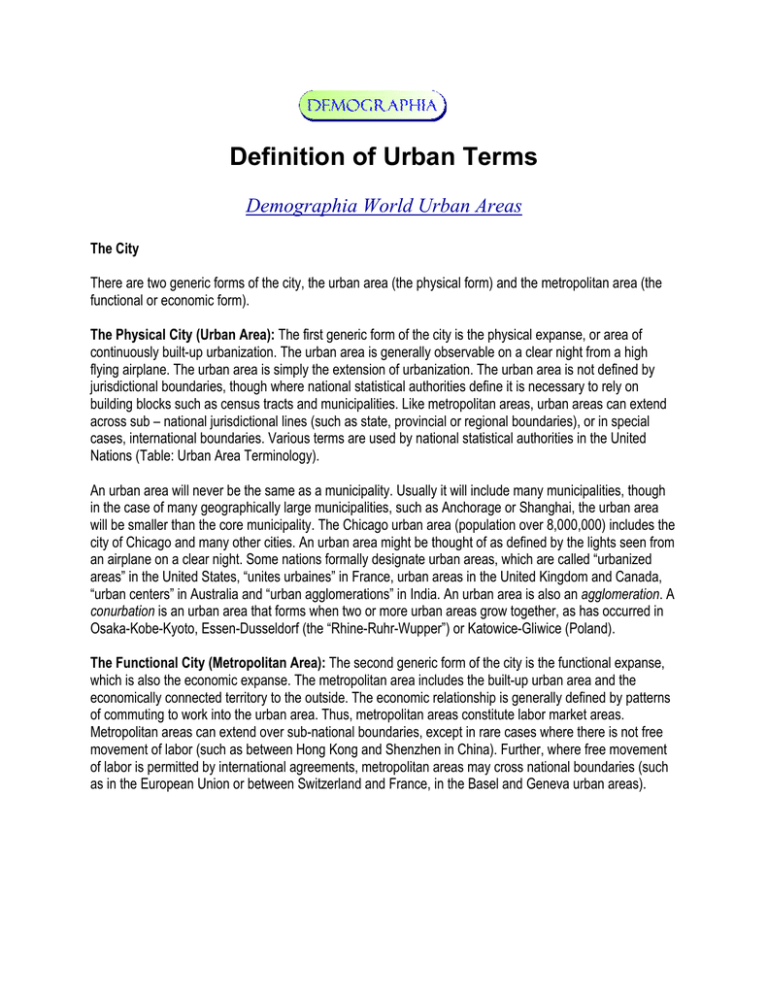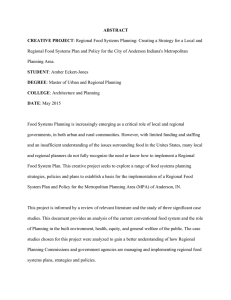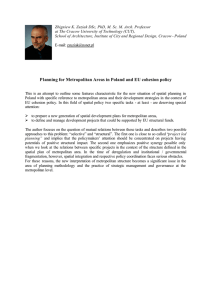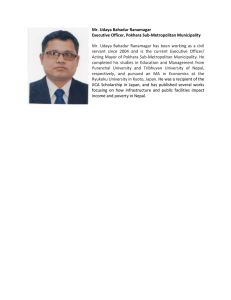Urban Terms: Definitions of City, Urban & Metro Areas
advertisement

Definition of Urban Terms Demographia World Urban Areas The City There are two generic forms of the city, the urban area (the physical form) and the metropolitan area (the functional or economic form). The Physical City (Urban Area): The first generic form of the city is the physical expanse, or area of continuously built-up urbanization. The urban area is generally observable on a clear night from a high flying airplane. The urban area is simply the extension of urbanization. The urban area is not defined by jurisdictional boundaries, though where national statistical authorities define it is necessary to rely on building blocks such as census tracts and municipalities. Like metropolitan areas, urban areas can extend across sub – national jurisdictional lines (such as state, provincial or regional boundaries), or in special cases, international boundaries. Various terms are used by national statistical authorities in the United Nations (Table: Urban Area Terminology). An urban area will never be the same as a municipality. Usually it will include many municipalities, though in the case of many geographically large municipalities, such as Anchorage or Shanghai, the urban area will be smaller than the core municipality. The Chicago urban area (population over 8,000,000) includes the city of Chicago and many other cities. An urban area might be thought of as defined by the lights seen from an airplane on a clear night. Some nations formally designate urban areas, which are called “urbanized areas” in the United States, “unites urbaines” in France, urban areas in the United Kingdom and Canada, “urban centers” in Australia and “urban agglomerations” in India. An urban area is also an agglomeration. A conurbation is an urban area that forms when two or more urban areas grow together, as has occurred in Osaka-Kobe-Kyoto, Essen-Dusseldorf (the “Rhine-Ruhr-Wupper”) or Katowice-Gliwice (Poland). The Functional City (Metropolitan Area): The second generic form of the city is the functional expanse, which is also the economic expanse. The metropolitan area includes the built-up urban area and the economically connected territory to the outside. The economic relationship is generally defined by patterns of commuting to work into the urban area. Thus, metropolitan areas constitute labor market areas. Metropolitan areas can extend over sub-national boundaries, except in rare cases where there is not free movement of labor (such as between Hong Kong and Shenzhen in China). Further, where free movement of labor is permitted by international agreements, metropolitan areas may cross national boundaries (such as in the European Union or between Switzerland and France, in the Basel and Geneva urban areas). Urban Area Terminology National Statistical Authorities and United Nations Nation Australia Canada Denmark Finland France India Netherlands Norway Sweden United Kingdom United Nations United States Term: English Equivalent Urban centre Population centre Urban area Urban area Urban Unit (Unité urbaine) Urban Agglomeration (see Notes) Urban area Urban area Urban area Built-up urban area Urban aggolmeration Urban area (includes urbanized areas and urban clusters) Notes: India: Land area data not available United Nations: Land area data not available A metropolitan area will nearly always be larger than the urban area, because urban areas routinely draw a large number of workers from surrounding rural territory. A metropolitan area may include more than one urban area. For example, the Los Angeles metropolitan area includes a number of urban areas, such as Los Angeles, Riverside-San Bernardino, Mission Viejo, Santa Clarita, Simi Valley, Oxnard-Ventura, and Palm Springs. The United States designates combined statistical (metropolitan) areas, which are routinely used in Demographia World Urban Areas, as opposed to their smaller metropolitan statistical area (MSA) components. Some but not most nations formally designate metropolitan areas (such as the United States, France, Brazil, India, Argentina, and Canada). Caution is appropriate with respect to the term “metropolitan.” For example, some jurisdictions within metropolitan areas are called “metropolitan” but are only a part of the metropolitan area. For example, "Metro Manila" refers to the National Capital Region, which is has less than half the population of either the urban area or the metropolitan area. The prefecture of Tokyo is often called the Tokyo metropolis, but twothirds of the urban area population and metropolitan area lives elsewhere. Further, the term “Greater” is often used to denote a metropolitan area, such as “Greater Los Angeles” or “Greater Chicago.” Again, this term is imprecise, because it is also used in some situations to denote municipalities that are only a part of a metropolitan area. For example, the municipality of Mumbai, is formally called the Municipal Corporation of Greater Mumbai and does not encompass either the entire urban area or the entire metropolitan area. The figure below illustrates the relationship between metropolitan areas, and their component parts (core municipality, urban area and exurbs). Parts of the urban area outside the core are considered "suburbs." Definition of Urban Terms EXAMPLE OF THE PARIS URBAN AREA EXURBAN: RURAL (Non-urban) EXURBAN: URBAN (Example: Mantes-la-Jolie URBAN AREA 412 Municipalities Including Core (Physical city: Area of continuous urbanization) CORE 1 Municipality (Ville de Paris) EXURBAN: RURAL (Non-urban) METROPOLITAN AREA 1,798 Municipalities including Urban Area (Functional or economic city) Confusion about the Term "City" There is considerable confusion over the term "city" and urban terms, such as "urban area" and "metropolitan area." This can result in misleading comparisons and less than sufficiently precise academic research. In some instances, academic literature, including econometric analysis, has made comparisons between noncomparable entities, such as metropolitan areas, urban areas and municipalities (The semantic problem of cities as municipalities is discussed below). Sometimes divisions of metropolitan areas have been compared to entire metropolitan areas/ Press reports routinely make comparisons between noncomparable urban entities. List of the largest cities sometimes mix metropolitan area populations (always representing the largest population of the two generic city forms), urban area populations and municipality populations. In one metropolitan area densities were compared to that of Manhattan, the extremely high density core of the New York metropolitan. The inappropriateness of this comparison is illustrated by the fact that Manhattan represents only 0.25 percent of the land area and less than 10 percent of the population of the New York metropolitan area. One of the most significant sources of confusion is the use of the term "city" to legally describe municipalities. With some notable exceptions, such as China, municipalities are virtually always smaller than their corresponding metropolitan areas or urban areas. By its very nature, urbanization in both the physical sense and the economic sense is not defined by the borders of single municipalities, large or small. Nonetheless, the larger municipalities in metropolitan areas or urban areas are sometimes confused as being the equivalent of the metropolitan area or urban area. These larger municipalities are more properly described as core municipalities or central municipalities. At the same time, a central municipality may be relatively small in relation to the corresponding urban area or metropolitan area. For example, according to the 2011 census, the central municipality of Melbourne had fewer than 100,000 residents according to the 2011 census, little more than two percent of the metropolitan area population. The central municipality of Adelaide had a population less than 20,020 11, less than two percent of the metropolitan area population. Even the central municipality of Sydney is comparatively small at 170,000 residents, less than four percent of the metropolitan area population. Further, outside China, nearly all metropolitan areas and urban areas contain multiple municipalities. For example, the Paris metropolitan area has nearly 1,800 municipalities according to the latest census data, while the urban area has more than 400 municipalities. The New York metropolitan area has more than 700 municipalities and the Pittsburgh metropolitan area nearly 400 municipalities.1 There are few major metropolitan areas in the world that do not contain multiple cities. Only one metropolitan area (Auckland) with more than 1,000,000 population in Western Europe, the United States, Japan, Canada, Australia or New Zealand is overseen by a single municipal government. Municipalities in China: Chinese cities (as the Chinese word is translated into English) are provincial level, sub-provincial level or prefectural level jurisdictions. In most cases, the municipalities of China are larger than their respective urban areas and in many cases they are larger than their respective metropolitan areas. Core Municipality: The central core municipality in an urban area or metropolitan area that emerged historically as the most prominent in the urban area. Almost without exception, the name of the core municipality is also shared with the urban area and the metropolitan area. For example, the metropolitan area that encompasses the municipality of New York is the New York metropolitan area or the New York urban area. Usually the core municipality will be the largest in the urban area or metropolitan area. However, this is not always so. San Jose, not a core municipality, is now the largest municipality in the San Francisco metropolitan area. Usually an urban area or metropolitan area will have many cities (the Paris metropolitan area has more than 1,000 municipalities or communes). The core municipality of Chicago, with nearly 3,000,000 residents, is just one of many cities in the Chicago metropolitan area or the Chicago urban area. It is, however, possible for the city to be larger than either the urban area or the metropolitan area. Examples are Anchorage, Alaska, and the Chinese cities of Chongqing, Beijing, and Tianjin. A core municipality usually includes the historical core. However, through annexation and consolidation, a central municipality may absorb areas that are suburban or rural in character. This has occurred in municipalities such as Portland, Los Angeles, San Antonio, Toronto, Mumbai and Rome. 1 http://www.demographia.com/db-metgovts2002.htm Functional Sectors of the City (Metropolitan Area) The following are the functional sectors of the city (also see the City Sector Model, for detailed analysis of US metropolitan areas at the postal code level).2 The Urban Core: Generally the urban core or the inner city is in the central municipality. Sometimes the urban core includes adjacent municipalities that developed during the same period as the core municipality. For example, Frederiksburg is a part of the core of the Copenhagen urban area, L’Hospitalet is a part of the core of the Barcelona urban area, and Cambridge is a part of the core of the Boston urban area core. Suburb: Collectively, the suburbs are all of the continuous urbanization that extends beyond the core municipality (all of the urban area except the historical core municipality and other adjacent historical municipalities). A specific suburb can be an individual municipality or community in the suburbs. For example, the cities of Evanston and Oak Park are suburbs of Chicago. In the London area, municipalities that are outside the Greater London Authority, but inside the greenbelt are suburbs, such as Epsom and Ottershaw (the London urban area is within the green belt). Exurban: Exurban refers to non-rural development that is within a metropolitan area, but outside the urban area. There are two types of exurban development: Exurb: An exurb is a municipality (or a community) or urban area in a metropolitan area that is separated by rural territory from the principal urban area. For example, DeKalb and Kankakee are exurbs of Chicago. The urban areas that are within the London metropolitan area, but outside the greenbelt, are exurbs, such as St. Albans and Milton Keynes. Low Density Exurban Development: Low density exurban development is generally large lot residential development that is not of sufficient density to be considered urban and is not agricultural. CITIES IN CHINA Analysts are often confused by the “city” (“shi” or 市 in Chinese) terminology used in China. Most (if not all) Chinese urban areas are contained within a single city (“shi”). While Chinese “cities” are municipalities, they are far different from municipalities in the western world, by virtue of their geographical size and vast rural territories. A better rendering of the Chinese word “shi” would be region or prefectures. All Chinese cities have internal political subdivisions (often translated as counties or districts). The provincial level cities are Shanghai, Beijing, Tianjin and Chongqing and represent the second level of government, under the central government, for their geographical areas. Each of the provinces and regions is divided into prefectural cities, sub-provincial level cities or other regions, each of which has considerable rural territory. Out of 333 prefectural level subdivisions of Chinese provinces and autonomous regions, 283 are cities, according to the China Statistical Yearbook.3 2 3 http://www.newgeography.com/category/story-topics/city-sector-model http://www.stats.gov.cn/tjsj/ndsj/2008/indexeh.htm In most cases, the prefectural and sub-provincial level cities are far larger than any plausible definition of either a metropolitan area. Further, all Chinese cities include rural territory and as a result cannot be urban areas. Generally, Chinese cities are “regions” and all territory in the nation is divided into cities or equivalent level jurisdictions. County level cities: To confuse the matter even further, some cities have county level subdivisions that are also cities. For example, Changsha, the prefectural level city and capital of Hunan has the usual county level subdivisions, one of which is a city, Liuyang. Like prefectural level cities, county level cities have considerable areas of rural territory. According to the China Statistical Yearbook, there are 368 county level cities in China. The urban area: Within the city or shi is the “shixiaqu” (市辖区), which is called the urban area and encompasses the urban districts (referred to as “qu”). Much of some urban districts is rural, especially those on the periphery of the urban area. Thus, the shiziaqu is not an urban area in the sense of an agglomeration (because an urban area or agglomeration is an urban footprint). Like most nations, China has no formal urban area or agglomeration designations that are consistent with those used in France, Canada, the United Kingdom and the United States. An Example: This is a confusing situation that baffles even experts. For example, a recent book on Chinese urbanization (The Concrete Dragon: China’s Urban Revolution and What it Means for the World by Thomas J. Campanella) states that the United States has 9 cities over 1 million population and that China has 102 (page 14).4 The comparison is inappropriate. The nine US cities are municipalities that are at the core of larger urban or metropolitan areas. The 102 Chinese “cities” are large regions (provincial level, prefectural level and sub-provincial level cities) that are nearly all far larger than their core urban areas or metropolitan areas. In 2015, there were 41 urban areas in the United States with more than 1,000,000 population and 100 in China. There are more large urban areas in China than in the United States, but the difference is by no means as large as Campanella indicates. A count of metropolitan areas is not possible, since there is no reliable definition of metropolitan areas in China. There is another statement to the effect that Wuxi (in the province of Jiangsu) is larger than Los Angeles. It is true that the prefectural level city of Wuxi has more than 4 million people and is larger than the city of Los Angeles, which has less than 4 million. However, the term “city” means very different things in the comparison. The “city” of Wuxi is a large region of more than 1,600 square miles (nearly 4,800 square kilometers). The core urban area of Wuxi, also called Wuxi covers 285 square miles (738 square kilometers) of the “city,” with more than 80 percent of the “city” being outside the urban area. The Wuxi urban area has a population of approximately 3.5 million. The city of Los Angeles, however, is at the core of an urban area with nearly 15 million people, more than four times that of the Wuxi urban area. The same page indicates that building the Three Gorges Dam destroyed nearly a dozen cities. In this case the use of the term city is more appropriate, because the reference is to urban areas and substantially different from the "municipal" definition referred to above.5 4 Thomas J. Campanella, The Concrete Dragon: China’s Urban Revolution and What it Means for the World, New York: Princeton Architectural Press, 2008, p. 14. 5 Nonetheless, the book is useful as a reference on general trends in China.



